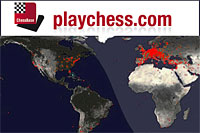Google Map's view of the venue

The Venue: CMS College, Kottayam
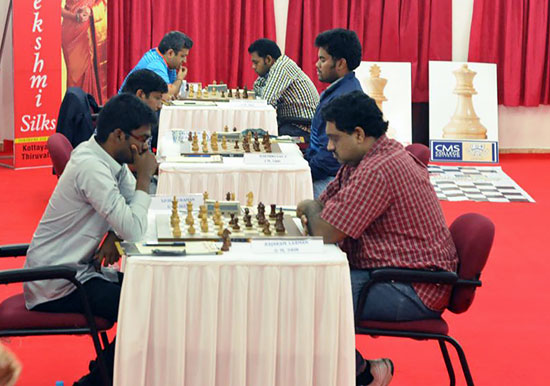
The competition underway
The tournament was originally intended to be a fourteen-player all-play-all event with eight Grandmasters and five International Masters fighting for a prize fund of 10 Lakh Indian Rupees – almost US$16,700 or 12,500 Euros. Nevertheless, it was shortened to a thirteen-player category 10 round-robin as defending champion GM Krishnan Sasikiran opted to skip the tournament after a gruelling month where he assisted Vishy Anand in his World Championship bid. This tournament gains added importance for the Indian players as it provides qualification spots in the Indian team for official events such as the World Cup, Asian Teams and Olympiad.
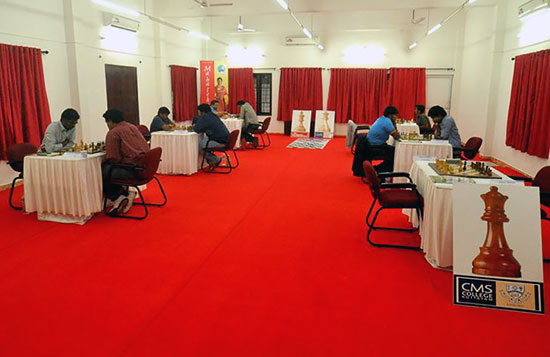
The event in progress
The tournament was won by 21 year old Grand Master S.P. Sethuraman who scored 8.5/12, half a point ahead of the remaining field. This victory enables him to represent India (Zone 3.7) in the FIDE events. He was part of the Bronze medal winning Indian team at the Tromso Olympiad, 2014.
Sethu, as he is popularly known in the Indian chess circle, is a sportsperson in the rolls of PSPB (Petroleum Sports Promotion Board of India) which has done yeomen service to excelling Indian chess players by supporting them in their endeavours. His parents and younger brother are also tournament level players.

Sethuraman (2622 FIDE) in action
Here are excerpts from a chat with the new Indian champion:
PB: Can you please comment on how you feel about your win?
Sethu: It feels great to win National Premiers, especially to qualify to the World Cup 2015.It has been my long time wish to play in the World Cup.
How were your preparations for this tournament?
Before the event I played Chigorin Memorial in Russia which was a good training tournament for me where I remained undefeated and finished third in a strong Open. Also, I had been playing consistent chess since Olympiad without losing a single game till now which was a great boost to my confidence.
Where does your career go from here?
As of now my main focus is to train hard and play my best at the forthcoming World Cup.
The crucial game in this tournament?
The game against GM Kunte was the most crucial; it was completely equal game after the opening. It was my preparation till the point when I played a6-b5.

[Event "SIB - CMS 52nd National Premeir Chess C"] [Site "CMS College, Kottayam"] [Date "2014.12.15"] [Round "10.2"] [White "Kunte, Abhijit"] [Black "Sethuraman, S.P."] [Result "*"] [ECO "D45"] [WhiteElo "2480"] [BlackElo "2622"] [Annotator "Sagar Shah"] [PlyCount "25"] [EventDate "2014.12.05"] {GM Sethuraman first equalises as black in the opening and then uses each and every move to improve his position in some way or the other through simple means.} 1. d4 d5 2. c4 c6 3. Nc3 Nf6 4. e3 e6 5. Nf3 Nbd7 6. Qc2 b6 7. cxd5 cxd5 (7... exd5 {is the much more popular way to recapture.}) 8. Nb5 Bb4+ 9. Bd2 Bxd2+ 10. Nxd2 O-O 11. Be2 (11. Rc1 {is more logical and White has pretty good results with it.}) 11... a6 12. Nd6 b5 {Sethuraman: It was my preperation till this point.} 13. O-O $6 {This is the start of all the White problems in the game.} (13. Rc1 Nb6 14. Qc7 $14 {gives white a small pull.}) *
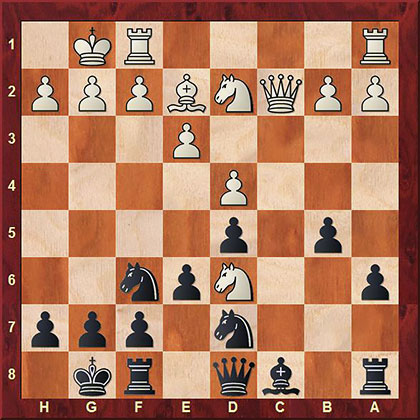
How does Black improve his pieces?
After he castled, it certainly seems that Black has an easier position to play.
Yes, my opponent actually offered a draw around move 16-17. I decided to continue a bit. He played 16.Rfb1 which was not required as 16.Rab1 was just equal and from that point he started to go a bit astray and I slowly improved my position. That was not a big mistake but slowly one small one creates another one and the position gets worse.
Yes, the domino effect.

[Event "SIB - CMS 52nd National Premeir Chess C"] [Site "CMS College, Kottayam"] [Date "2014.12.15"] [Round "10.2"] [White "Kunte, Abhijit"] [Black "Sethuraman, S.P."] [Result "0-1"] [ECO "D45"] [WhiteElo "2480"] [BlackElo "2622"] [Annotator "Sagar Shah"] [SetUp "1"] [FEN "r1bq1rk1/3n1ppp/p2Npn2/1p1p4/3P4/4P3/PPQNBPPP/R4RK1 b - - 0 13"] [PlyCount "41"] [EventDate "2014.12.05"] 13... Nb6 14. Nxc8 Rxc8 {It is clear that the opening has gone wonderfully well for Black. He not only controls the open c-file but also has more space on the queenside. From this point onwards it is very instructive to see how little by little Sethuraman improves his position and outplays his experienced opponent.} 15. Qd3 Nc4 16. Rfb1 (16. b3 {weakens the c3 square and black can take immediate advantage of it.} Nxd2 17. Qxd2 Ne4 18. Qb2 Nc3 19. Rfc1 Qa5 $15 {and Black has some pressure.}) ({Sethuraman:} 16. Rab1 {is just equal.}) 16... Qd6 {connecting the rooks} 17. Nf1 Rc6 {Doubling the rooks along the only open file on the board.} 18. Qd1 Rfc8 19. Bd3 a5 {trying to gain further space on the queenside.} 20. h3 {h3 prevents Ng4 in the future but does nothing much to improve his position. Sethuraman keeps piling now.} (20. b3 Na3 21. Rc1 {might have offered better chances to White.}) 20... Ne4 21. Qe1 b4 22. f3 Nf6 23. Qe2 e5 $1 {The move f3 weakened the white pawns structure and also the king placement to a certain extent and hence this break in the center is extremely logical.} 24. Rc1 (24. dxe5 Qxe5 25. f4 Qe7 $15) 24... exd4 25. exd4 Nh5 $1 { The knight looks at the juicy dark squared weaknesses.} 26. Qf2 Nf4 27. Rd1 ( 27. Bf5 R8c7 28. Re1 g6 {was no better.}) 27... Qf6 28. Rab1 Re6 29. b3 Nd6 30. Nh2 h5 $1 {preventing Ng4 and gaining further space on the kingside. Little by little you can see how Sethuraman has take control of the entire board.} 31. Bf1 Qg6 {Threatening the Nxh3.} 32. Qh4 Ne2+ (32... Nxg2 33. Bxg2 Re2 $19 {was another way to win.}) 33. Kh1 Nf5 $1 {It will be a beautiful finish on the g3 square. The simplicity of the game made me feel as if it was Capablanca or Smyslov who was donning the black pieces!} 0-1
In the first two games I had worse positions but managed to save them - I defended well. But against Swayams I was clearly losing and I was lucky. The game against Deep was good as well as the Sahaj game. Comparatively, last year’s edition was much stronger with Sasikran there. Still, this time it was a tough event as you could see, and there were lots of upsets, especially in the last round when Vidit lost his game to veteran IM Girinath. As of my competitors, Deep Sengupta, who finished second, was the closest. He played interesting chess and lost only against me.
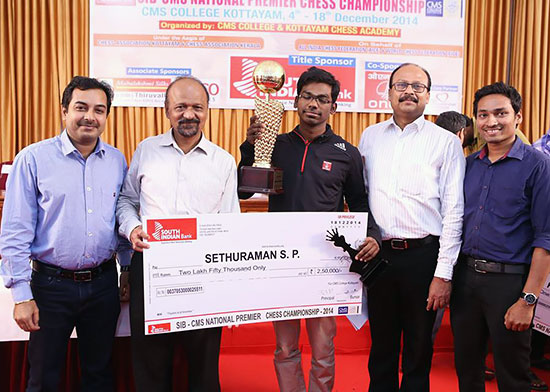
Sethu with his winnings
The second position was taken on tie-break by GM Deep Sengupta who scored 8.0/12. GM Deep is former World U-12 Chess champion and is also a sportsperson representing the PSPB which, as mentioned before, is a sporting giant in India’s public sector.

[Event "SIB - CMS 52nd National Premeir Chess C"] [Site "CMS College, Kottayam"] [Date "2014.12.08"] [Round "4.2"] [White "Sengupta, Deep"] [Black "Grover, Sahaj"] [Result "1-0"] [ECO "B96"] [WhiteElo "2566"] [BlackElo "2505"] [Annotator "Sagar Shah"] [PlyCount "39"] [EventDate "2014.12.05"] {The poisoned pawn variation in the Najdorf is quite a dangerous system for both sides. Very deep opening knowledge is required to play it. However, the black player has to be extra careful because he is grabbing a pawn at the cost of his development. One mistake and it's all over. That is exactly what happens in this game.} 1. e4 c5 2. Nf3 d6 3. d4 Nf6 4. Nc3 cxd4 5. Nxd4 a6 6. Bg5 e6 7. f4 h6 (7... Qb6 {was the actual poisoned pawn variation that was played by the great Bobby Fischer and Kasparov. Black players have started to realise that flicking in h6 gives them many more options later on.}) 8. Bh4 Qb6 9. Qd3 Qxb2 {If you have said 'a' you must say 'b'.} 10. Rb1 Qa3 11. f5 (11. e5 {is the other possible move in the position.}) 11... Be7 12. fxe6 Bxe6 13. Nxe6 fxe6 {Black has been doing quite well in this position with two of Anand's seconds Sandipan and Wojtaszek scoring wins with black. Objectively Black is very fine but he must be careful as the white pieces are pretty active.} 14. e5 dxe5 15. Bxf6 gxf6 (15... Bxf6 16. Qg6+ Ke7 17. Ne4 {might lead to some very interesting complications as seen in the game Carlsson-Penalver.}) 16. Be2 e4 { I am unsure whether this is all Sahaj's preparation or not, but he has definitely played the best move in the position.} 17. Bh5+ Kf8 18. Qh3 Bb4 $4 { A horrible blunder by Sahaj. Just shows how every move is important in such sharp positions. From being an interesting and complicated game, it turns into an elementary victory for White.} (18... Nd7 {developing the knight and safeguarding the important squares would have been a better choice.} 19. Qxe6 $2 Qxc3+ 20. Kf1 Ne5 $19) 19. O-O $1 {Deep doesn't have to be asked twice to sacrifice the c3 knight. He gets a direct view to the black king on f8.} Qxc3 20. Qxe6 {There is no way to prevent the mate so Sahaj threw in the towel. The poisoned pawn variation is truly a poisonous opening!} (20. Qxe6 Qc5+ 21. Kh1 Qxh5 22. Qxf6+ Ke8 23. Rxb4 $18) 1-0

GM Vidit Gujarathi vs GM Deep Sengupta
The surprise of the event was 25-year-old IM P. Karthikeyan representing Railways (India) who tied for second, but had to settle for third place, scoring 8.0/12. He clocked a rating performance of 2619 to register his third and final Grandmaster norm and increased 35 rating points in the process. However, the former Asian Junior Champion needs to raise his rating above 2500 to become a GM.
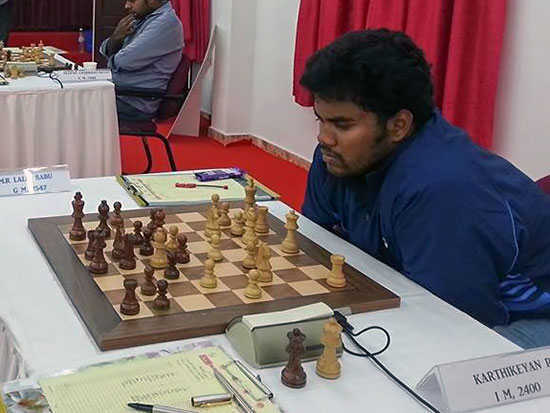
IM P. Karthikeyan
A chat with IM Karthikeyan after the tournament:
PB: Can you please comment on how you feel about your performance?
Karthikeyan: It feels good because my family is happy and that’s more important to me than this performance!

Karthikeyan playing his wife Harini Sankaran (2046 FIDE) at a tournament
How were your preparations for this tournament?
ICF Railways, where I work, gave me 20 days preparation leave which was very useful to study my opponents and find their weaknesses. I took a meditation and yoga class before and during tournament which was very helpful for making me calm under time trouble and take proper decisions.
Let us talk about your game with GM Deepan Chakravarthy.
Well, it was an English attack which I was not expecting. Since he plays so many variations, it was difficult. I had analysed it earlier but during the game I remembered the positional line where black plays Nb6 and white continues a4. I remembered a recent Shirov game with black pieces where he equalised but I was feeling so energetic - I wanted to castle long and attack!

[Event "SIB - CMS 52nd National Premeir Chess C"] [Site "CMS College, Kottayam"] [Date "2014.12.14"] [Round "9.1"] [White "Karthikeyan, P."] [Black "Deepan, Chakkravarthy J"] [Result "*"] [ECO "B80"] [WhiteElo "2400"] [BlackElo "2489"] [Annotator "Sagar Shah"] [PlyCount "22"] [EventDate "2014.12.05"] 1. e4 c5 2. Nf3 d6 3. d4 cxd4 4. Nxd4 Nf6 5. Nc3 e6 6. Be3 (6. g4 {Usually players are quite scared of the Keres Attack that starts with the move g4. But here Karthikeyan chooses the English Attack.}) 6... a6 7. f3 b5 8. Qd2 Bb7 9. g4 Nfd7 {Based on the results this is the best line for Black.} (9... Nbd7 10. g5 Nh5 11. O-O-O {is another way to play.}) 10. O-O-O Nb6 11. h4 N8d7 *
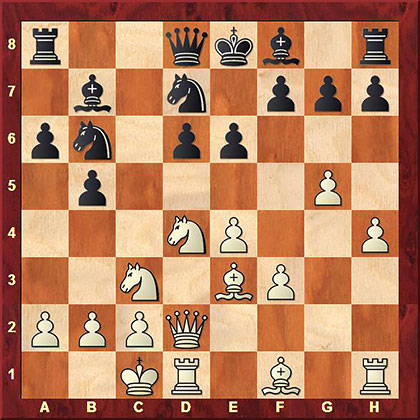
White plays 12.g5 signalling an all-out attack
It was felt that a direct g5 was planless.
I remembered Kb1 and Qf2 should be played before pushing g5 or h5 but feared the classic Kasparov idea where Black plays Rc8 and Rxc3, so I went with the flow.

[Event "SIB - CMS 52nd National Premeir Chess C"] [Site "CMS College, Kottayam"] [Date "2014.12.14"] [Round "9.1"] [White "Karthikeyan, P."] [Black "Deepan, Chakkravarthy J"] [Result "*"] [ECO "B80"] [WhiteElo "2400"] [BlackElo "2489"] [Annotator "Sagar Shah"] [SetUp "1"] [FEN "r2qkb1r/1b1n1ppp/pn1pp3/1p6/3NP1PP/2N1BP2/PPPQ4/2KR1B1R w kq - 0 12"] [PlyCount "12"] [EventDate "2014.12.05"] 12. g5 {White's play looks a little planless. He is pushing the pawns on the kingside but there is nothing really to attack on the kingside and the black king is still in the center.} b4 $1 13. Nb1 (13. Nce2 Nc4 14. Qd3 Rc8 15. Bf2 d5 $19 {Black is very comfortable and has nearly decisive advantage.}) 13... d5 $1 {A perfect break in the center.} 14. Bh3 {White is eyeing for a sacrifice on the e6 square but the problem is that Black's queenside counterplay is just too quick.} Nc4 15. Qe2 Qa5 16. b3 Nxe3 17. Qxe3 dxe4 (17... Qxa2 $2 {The knight on b1 shows its worth now as it perfectly defends the white king and the black king is cut to pieces.} 18. exd5 $18) *
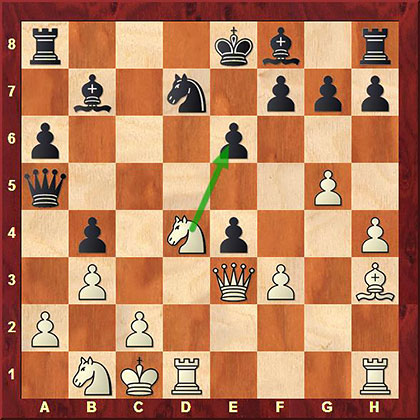
You went all in with a sacrifice on e6. Objectively, it is incorrect.
After an early g5 I can’t come back. I should go with the flow. The position needed the sacrifice on e6 otherwise it’s just lost. Yes, with engines it is easy to defend but during the game I found it so interesting – it was the only way to turn the tables.
How much time did you spend on this move? Isn’t it tough to convince ourselves to go ahead with a sacrifice?
Yes, I understand but all other moves will give me a weak position. I thought for about 15-20 minutes and just went for it. Additionally, for the last ten moves, we had only five minutes on the clock to reach the first time-control.
The finishing tactic is nice; the game never saw the time-control!

[Event "SIB - CMS 52nd National Premeir Chess C"] [Site "CMS College, Kottayam"] [Date "2014.12.14"] [Round "9.1"] [White "Karthikeyan, P."] [Black "Deepan, Chakkravarthy J"] [Result "1-0"] [ECO "B80"] [WhiteElo "2400"] [BlackElo "2489"] [Annotator "Sagar Shah"] [SetUp "1"] [FEN "r3kb1r/1b1n1ppp/p3p3/q5P1/1p1Np2P/1P2QP1B/P1P5/1NKR3R w kq - 0 18"] [PlyCount "31"] [EventDate "2014.12.05"] 18. Nxe6 $5 {Karthikeyan understands that the situation is desperate and goes all in. However his sacrifice is incorrect and Deepan proves it by playing accurately at least for the next few moves.} fxe6 19. Bxe6 Ne5 20. f4 Nf3 { Black is just winning now. Not only is he a piece up but his pieces are also developing quite easily.} 21. Rd7 (21. Bd7+ Kf7 {is nothing.}) 21... Bc6 22. Rhd1 Bc5 {The last black minor piece develops with a tempo.} (22... Bxd7 $2 23. Bxd7+ Kf7 24. Qxe4 $18) 23. Qe2 Qb5 24. Bf7+ Kf8 25. Bc4 Qb6 26. Rf7+ Ke8 27. c3 {White had to make some arrangements against Be3+ and hence played his pawn to c3. At this point the computer gives an advantage of almost five points to Black.} (27. Kb2 Bd4+ 28. c3 bxc3+ 29. Nxc3 Rd8 $19) 27... Rf8 (27... Rd8 { Eliminating the other rook was easier.} 28. Rxd8+ Kxd8 $19) 28. Rxg7 Ra7 29. Rxa7 Qxa7 30. Bxa6 Rxf4 31. Qc4 {White has some counterplay now as the queen is looking to check the black king. But the computer feels nothing at all is happening. It still assesses Black's position as totally won. Sitting at home with Houdini running it is easy to see the evaluation of -+ 4.5 and assume that this is an easy position for Black. On the board with lot of pressure and little time on the clock it is easy to go wrong. And Deepan makes huge blunder that allows a mate in four.} Ne5 $4 (31... Ke7 32. Bc8 Be8 33. Qe6+ Kf8 34. Rd8 Qf7 $19 {Was quite a tricky sequence of moves but would have ensured the victory for Black.} (34... Be7 35. Qh6+ $18)) 32. Qe6+ Qe7 (32... Kf8 33. Rd8+ Kg7 34. Rg8#) 33. Rd8+ $3 {A bolt from the blue and it is all over. A depressing result for Deepan Chakravarthy who played a very nice game until the very end. But once again the age old proverb turns out to be true: "The man who makes the second last blunder is the one who wins!"} (33. Rd8+ Kxd8 34. Qc8#) 1-0
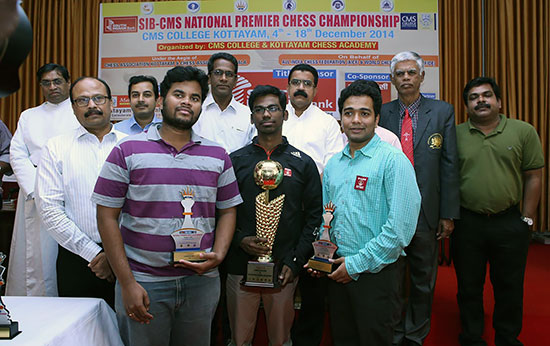
The three prize winners with other dignitaries
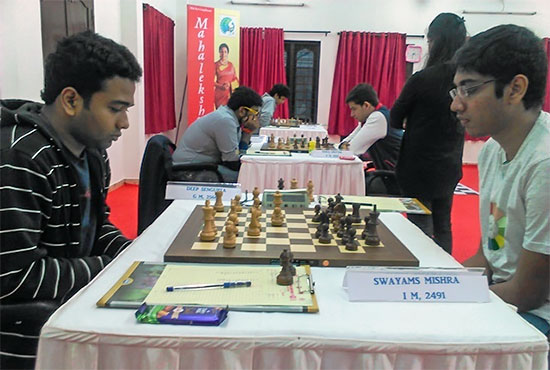
GM Deep Sengupta playing IM Swayams Mishra
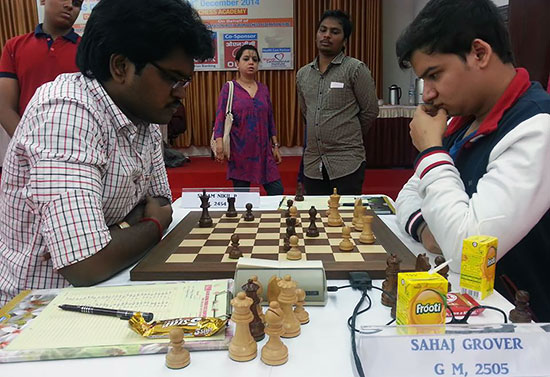
IM P. Shyam Nikhil playing GM Sahaj Grover

A parallelogram: GM Kunte playing GM Deepan
Interestingly, of the 78 games played in this tournament, 39 ended decisively and 39 games were drawn. Quite a few of them went down interesting roads. Here are some impressions with analysis by IM Sagar Shah and IM Prathamesh Mokal:
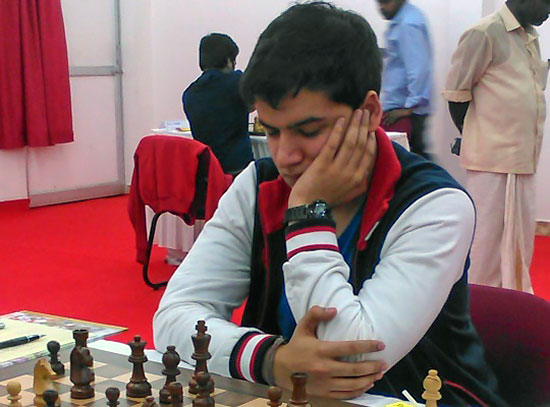
GM Grover executes a beautiful idea (notes by IM Sagar Shah)

[Event "SIB - CMS 52nd National Premeir Chess C"] [Site "CMS College, Kottayam"] [Date "2014.12.15"] [Round "10.5"] [White "Deepan, Chakkravarthy J"] [Black "Grover, Sahaj"] [Result "0-1"] [ECO "D40"] [WhiteElo "2489"] [BlackElo "2505"] [Annotator "Sagar Shah"] [SetUp "1"] [FEN "r2q1rk1/1p3ppp/p1nb1n2/3p4/6b1/PPN1PN2/4BPPP/R1BQ1RK1 b - - 0 12"] [PlyCount "23"] [EventDate "2014.12.05"] {Why am I showing you a boring Isolated Queen Pawn position? Because the young GM called Sahaj Grover now shows a beautiful idea which is worth adding to your attacking arsenal.} 12... d4 $3 13. exd4 {Deepan takes the pawn and asks Sahaj what exactly is his idea.} (13. Nxd4 Nxd4 14. Qxd4 (14. Bxg4 Nxg4 15. Qxg4 Nxb3 $15) 14... Qc7 $1 15. Nd5 $1 (15. Bxg4 Bxh2+ 16. Kh1 Be5 $17) 15... Nxd5 16. Qxg4 Bxh2+ 17. Kh1 Be5 {Black is not worse.}) 13... Qa5 $1 {Attacking the undefended knight but it is just a stepping stone towards a glorious journey. The black queen aims to take out the white monarch!} ({Sahaj was not attracted by the tame idea of regaining the pawn with} 13... Bxf3 14. Bxf3 Nxd4 15. Bxb7 (15. Bb2 Nxf3+ 16. Qxf3 $11) 15... Rb8 (15... Bxh2+ 16. Kxh2 Qc7+ 17. Kg1 Qxc3 18. Bd2) 16. Bxa6 Nxb3 $11 {with equal chances.}) 14. Bd2 Qh5 $1 { With three imaginative moves, Sahaj has transferred his queen to a very dangerous location and threatens mate on the h2 square.} 15. g3 {The most human move.} (15. h3 Bxh3 16. gxh3 Qxh3 $19 {needs no real explanation. The knight is coming to g4 and soon it will be all over.}) (15. h4 {is an important defensive move that should become a part of your arsenal. The point is that Black has to give up his light squared bishop to continue that attack.} Bxf3 16. Bxf3 Qxh4 17. g3 Qxd4 (17... Bxg3 18. fxg3 Qxg3+ 19. Bg2 $16) 18. Be3 Qxc3 19. Qxd6 $15 {Black is a pawn up but with these two bishops, White does have some compensation.}) 15... Rfe8 $1 {Black threatens to take on e2.} 16. Be3 Rad8 {In spite of being a pawn down, Black's position is a picture of harmony.} 17. Ra2 Ne7 {The c6 knight was not contributing to the attack and hence is taken to f5.} 18. Bg5 $2 (18. Nh4 {could have been a better idea.} Ng6 19. Nxg6 hxg6 $15 {With a dangerous initiative for Black but it is better than what occured in the game.}) 18... Ned5 $1 {The c3 knight is attacked and sacrifices beckon on the e2 square. Also the g5 bishop is loose. It's all over. } 19. Nxd5 Rxe2 $1 20. Rxe2 (20. Nxf6+ gxf6 21. Rxe2 Bxf3 $19) 20... Bxf3 21. Bxf6 Bxe2 22. Qd2 Re8 $1 {The material is even currently but once again White is badly tied up. His knight on d5 is attacked and it cannot move because the f6 bishop will fall.} 23. Qa5 b6 $1 {A nice little deflecting move. White loses a piece. A brilliant attacking game by Sahaj who showed some very interesting ideas in the isolated pawn structure.} 0-1
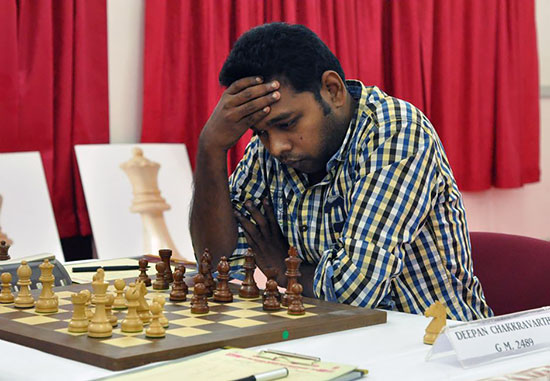
GM Deepan Chakravarthy played a game with a famous parallel
As pointed out by FIDE Senior Trainer and IM Prathamesh Mokal, the extraordinary position from the game bore a significant resemblance to a classic.
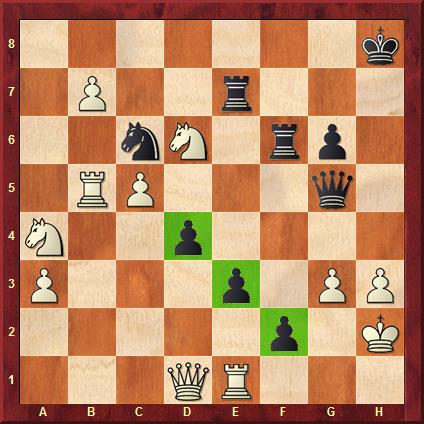
This remarkable position was reached after 36...f2 in Rajesh-Deepan

This was the finish of McDonnell-De Labourdonnais (1834)
The full game with commentary by IM Prathamesh Mokal:
[Event "52nd National Premier"] [Site "CMS College, Kottayam"] [Date "2014.12.10"] [Round "6.6"] [White "Rajesh, V A V."] [Black "Deepan, Chakkravarthy J"] [Result "0-1"] [ECO "E90"] [WhiteElo "2408"] [BlackElo "2489"] [Annotator "Mokal,Prathamesh"] [PlyCount "158"] [EventDate "2014.12.05"] [EventRounds "13"] [EventCountry "IND"] {The following impressive game was played in the spirit of the King's Indian Defense.} 1. d4 Nf6 2. c4 g6 3. Nc3 Bg7 4. e4 d6 5. h3 {This line has gained popularity in the last few years.} O-O 6. Nf3 e5 7. d5 Nh5 8. Be3 {This move is rare. White's main continuations are 8.Nh2 and 8.g3.} f5 9. Bd3 f4 10. Bd2 a5 11. a3 c5 12. dxc6 (12. O-O {is worth considering.}) 12... bxc6 13. b4 Kh8 14. O-O Bf6 $5 {An interesting manoeuvre follows. Black eyes the d4 square with ...Ng7-e6. It will also free the path for Black's h-pawn to move forward and join its compatriot to storm the White King's Castle. The closed nature of the position allows for such possibilities.} 15. b5 Ng7 16. Rb1 Ne6 17. Re1 h5 18. Be2 Ra7 $1 {Another interesting manoeuvre. The Rook is ready to join the attack without the minor pieces on b8 and c8 being developed. Black plans to use the minimum number of pieces to hold up White's army on the Queenside.} 19. b6 Rh7 20. Na4 Bb7 21. c5 d5 22. exd5 {White banks on his Queenside passed pawns but surrenders the centre.} ({It needed to be seen if White could avoid this and hold up his centre.} 22. Bxa5 Qe7 (22... dxe4 23. Qxd8 Rxd8 24. Bc4 exf3 25. Bxe6 $16 {is good for White. Black would naturally not want to take the Queens off the board.}) 23. Bd3 d4 $40 {So White could have succeeded in his ambition, but now with the centre closed Black can switch to a flank attack with ...g5-g4.} (23... g5 $2 24. exd5 cxd5 25. Nxe5 $18)) 22... cxd5 23. Bb5 e4 24. Bxa5 Re7 25. Nd2 Nd4 {Black is keen to start rolling his pawns, so he gets the Knight out of the Rook's way.} (25... Nc6 $5 {was a decent alternative.}) 26. Bc3 Nxb5 27. Bxf6+ Rxf6 28. Rxb5 d4 {The avalanche begins.} 29. Nc4 Qd5 30. Na5 f3 31. Nxb7 Qg5 $1 {In typical King's Indian fashion Black does not worry about the Queenside pieces and goes for the attack.} 32. g3 Nc6 (32... h4 $2 33. c6 $18) 33. Nd6 (33. h4 Qg4 34. Kh2 g5 $1 $17 {and Black is still winning.}) (33. Kh2 h4 (33... e3 34. h4 $1) 34. g4 e3 $17 {is again great for Black.}) 33... e3 34. Kh2 (34. h4 $2 {Doesnt help.} exf2+ 35. Kxf2 Re2+ 36. Rxe2 fxe2+ 37. Kxe2 Qe3#) 34... h4 $1 $19 {Undermining! This is a dream position for a Kings Indian player.} 35. b7 hxg3+ 36. fxg3 f2 {The pawns reminds one of the very first game from Kasparov's 'My Great Predecessors' Volume 1 - McDonnell vs La Bourdannais, 1834!} 37. b8=Q+ Nxb8 38. Rxb8+ Kh7 39. Re8 (39. Rb7 Rxb7 40. Nxb7 fxe1=Q 41. Qxe1 Rf2+ $19 {is curtains for White.}) 39... Rxe8 40. Nxe8 Rf8 41. Rf1 Rxe8 $2 {Missing a simple win. It is very unfortunate considering that Black had played really well so far.} (41... Qe7 $142 42. Qxd4 e2 43. Rxf2 Rxf2+ 44. Qxf2 e1=Q $19 {This would have been a real crowning glory.}) 42. Qxd4 e2 43. Rxf2 Qe7 ({White has a nice perpetual check if Black promotes the pawn.} 43... e1=Q 44. Rf7+ Kh6 45. Qg7+ Kh5 46. Qh7+ Qh6 47. Rf5+ gxf5 48. Qxf5+ Qg5 49. Qh7+ Qh6 50. Qf5+ $11) 44. Nc3 $2 {White misses his opportunity.} (44. Qc4 $142 Qe6 (44... e1=Q 45. Rf7+ Kh8 46. Rxe7 Rxe7 (46... Qxe7 47. Qd4+) 47. Qc3+ Qxc3 48. Nxc3 Re5 {leads to similar positions but with a better version for White.}) 45. Qxe6 Rxe6 46. Rxe2 Rxe2+ 47. Kg1 Rc2 $11 {White will lose the c-pawn after... Rc4 and later the a-pawn as well but if he plays accurately after that, the game is very likely to end in a draw.}) 44... e1=Q 45. Nd5 Rf8 $1 46. Nf6+ (46. Nxe7 Rxf2+ $19) 46... Rxf6 47. Qxf6 Qxf6 48. Rxf6 Qd2+ $19 {The rest is a matter of technique.} 49. Kg1 Qc3 50. Rf7+ Kg8 51. Rf2 Qxg3+ 52. Rg2 Qxh3 53. Rxg6+ Kf7 54. Rg2 Qxa3 55. c6 Qc1+ 56. Kh2 Qxc6 57. Kg3 Kf6 58. Rf2+ Kg5 59. Rf3 Qe4 60. Rf2 Qe3+ 61. Kg2 Kg4 62. Kf1 Qe4 63. Re2 Qh1+ 64. Kf2 Kf4 65. Rd2 Qh2+ 66. Ke1 Qg1+ 67. Ke2 Ke4 68. Rc2 Qg2+ 69. Kd1 Qf1+ 70. Kd2 Kd4 71. Rb2 Qf2+ 72. Kc1 Qe1+ 73. Kc2 Kc4 74. Ra2 Qe2+ 75. Kb1 Qd1+ 76. Kb2 Kb4 77. Ra1 Qd2+ 78. Kb1 Kb3 79. Ra3+ Kxa3 0-1
Final standings
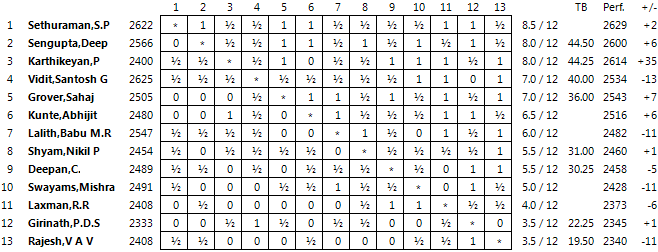
Special thanks to IM Sagar Shah for choosing and analysing the games, FIDE Senior Trainer and IM Prathamesh Mokal for analysing the Rajesh vs. Deepan game.
Photos by Rajesh Nattakom







































